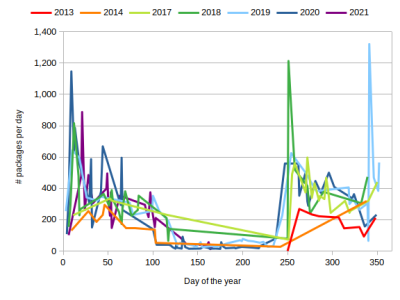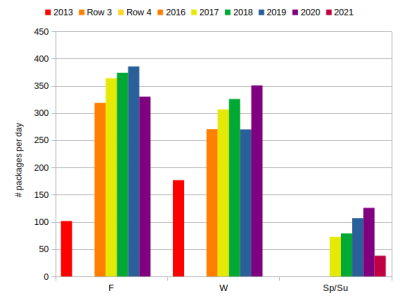Getting packages in University Housing
I attended university from 2013 through 2021, and much of that time in on-campus housing. This was apartment-style, with 4-6 residents per apartment, and hundreds of apartments spread across the complex’s 1-2 dozen buildings. To ease the duties of the postal carriers, all mail was delivered to one building in the complex, where there were letterboxes for each apartment. However, these letterboxes were quite small, so anything bigger than a thin magazine was assigned a number by the staff and a notice was sent to the resident to pick up this package.

The complex originally had 23 buildings with 10 apartments each, but during the time I was there, the buildings were gradually demolished and replaced with 15 buildings containing ~40 apartments each. The image to the left shows the old buildings in front (partially demolished), with new buildings in the background. This greatly expanded the number of residents, and at the same time the rise of Amazon and the like increased the number of packages received each day. By how much? Well, that’s where those package numbers come in.
When I first moved in, package numbers were only 4 digits, but that was upped to 5 only two months later. I guess numbers had started to cycle faster than the slowest students picked their stuff up, and there may have been some duplicate numbers. As I continued to get more packages, I noticed that the numbers appeared to be always ascending, and thus were probably not randomly-generated. My curiosity piqued (I spent freshman year taking engineering pre-reqs, can you tell?), I started keeping track of the numbers in a spreadsheet.
Seven and a half years later, I got my final package and the spreadsheet was complete. Overall, it resulted in a couple pretty graphs. But there were also a few interesting things along the way:
The sequential-number thing held true, and actually in 2021 there was an apparent hiccup in the automated messaging, and a 6-digit number (6XXXXX) was sent for a single package. Keeping track of how many times the number had “rolled over” (and estimating for the 2 years I was off-campus), it tracks with when the package numbers went from 4 to 5 digits. Extrapolating backwards a bit, it seems like the “zero-date” was during the fall of 2013, right before the introduction of the 5-digit numbers. Apparently before that it just looped, or there was some other system. In any case, in the 7 1/2 years I was there the front desk workers apparently processed around 680,000 packages - an average of 90,000 per year or 250 each day!
 There are peaks around the start of each semester, when students arrive and get new books, order things they forgot to pack, etc. Some years I was better able to capture these peaks than others. Since the average number of packages a day can only be calculated between dates where I got a package, the resolution of the data keeps changing. (click on the image for an enlarged version)
There are peaks around the start of each semester, when students arrive and get new books, order things they forgot to pack, etc. Some years I was better able to capture these peaks than others. Since the average number of packages a day can only be calculated between dates where I got a package, the resolution of the data keeps changing. (click on the image for an enlarged version)
There is one exception to this - in late 2019, all apartment buildings were re-numbered, and there was a corresponding dip and then spike in the packages per day. I actually had packages for several days in a row during this period, so the resolution is quite high. The packages per day dropped from the 300s to below 100, before spiking to 1300 the day after the change. My guess is that the packages were held for a couple days to make sure the addresses correlated (or the staff suddenly had to do all this correlation, and fell behind until they got the additional help that would require).

Plotting this by school terms, it is clear that the number of packages kept increasing (at least until many students went remote during the Winter 2019 / Fall 2020 semesters (2020-1 to 2020-12)). However, by Winter 2020 (2021-1 to 2021-4) everything appears to be back on track. It is also notable that for many years the number of packages is on average lower during the Winter term - perhaps this is due to the holidays, where students would have received items that otherwise would have been mailed.
Other interesting facts include:
- I recived adjacent package numbers 4 times, 3 of which occurred during the late spring / early summer of 2020. The residences were very empty during this time, resulting in only 1-2 dozen packages per day.
- My lowest “Package Number” was
00220, and my highest was 99890, missing the 99999-00000 flip by only a day or so both times.
- I received 228 packages in all, or roughly a package every 12 days.
- Assuming I received an average number of packages puts the average number of residents at 3,000 - which is fairly accurate!


